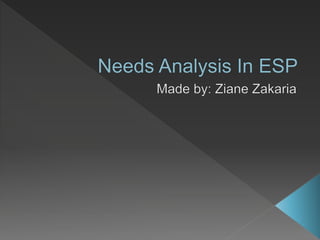
Types of Needs analysis in ESP
- 2. 1- Introduction to Needs Analysis in ESP 2- Types of Needs Analysis 2.1- Target Needs 2.1.1- Necessities 2.1.2- lacks 2.1.3- wants 2.2- Learning Needs 3- The Importance of Needs Analysis in ESP 4- Conclusion
- 3. Needs analysis is considered to be the cornerstone of English for Specific Purposes (ESP). The concept of Needs analysis has been different along the decades. At the initial stages of ESP( the 1960s and early 1970s), needs analysis consisted in assessing the communicative needs of the learners and the techniques of achieving specific teaching objectives. Nowadays, the tasks of needs analysis is much more complex: it aims at collecting information about the learners and at defining the target situation and environment of studying ESP.
- 4. Hutchinson (1991:54) states that there are two kinds of needs, target needs and learning needs. The former implies what the learner needs to do in the target situation and the latter what he needs to do in order to learn
- 5. Target needs is a general term that encompasses the learners’ necessities, lacks and wants. According to Hutchinson and Waters (1987) it mainly related to ‘what the learner need to do in the target situation’.
- 6. Necessities are a type of need determined by the demand of the target situation, to put it in a simple term it is what the leaner has to know in order to function accordingly in the target situation.
- 7. An example taken from Munby (1978), it shows the necessities for a learner who works as a head waiter in a hotel
- 8. Lacks are what the learners already know and what they are deficient in. According to what they know we decide what necessities they’re missing. Lacks are the gap between the target proficiency and the existing proficiency of the learners.
- 9. So far, we looked at target needs only in an objective term, with no regards to the learners own subjective hopes. As Richterich (1984:29) comments: ‘… a need does not exist independent of a person, it is the people who build their image of their needs on the basis of data relating to themselves and their environment’.
- 10. So to put it simply, wants are the learners own personal subjective expectations. these wants may conflict with the necessities as perceived by the course designer, so there must be a way to accommodate them both and find an appropriate middle ground. Keep in mind that individuals’ wants may not be all met but the wants of the majority can certainly be discussed and relatively met.
- 11. Learning needs are about the learners' motivation of learning the language, the way they prefer to learn, the available resources, the time and place the course will take place and the learners' personal information. Hutchinson and Waters compare the Business English course to a journey. The starting point of the journey is the "lacks" and the destination is the "necessities". Learning needs are how are the learners get from the starting point to the destination. Sometimes the "destination" may be deviated because the "necessities" perceived by the sponsors may be different from what the learners want or feel they need ”wants”.
- 12. Its useful to think of learning needs as a route, if the learner doesn’t find this route engaging enough it will lose his interest, so its important to make the route as interesting as possible. For example, when preparing material for a group of learners who need to read texts on systems, most of the available texts tend to be long and dull, so should these texts be used for ESP? certainly not! . The motivation of the learners may not carry over the ESP course, even if they manage to go through the texts this does not imply that they learned from dull texts. It is important to look for texts that are more interesting or even humorous to capture and generate the motivation needed for the ESP course to be effective.
- 13. As we know ESP emerged as an answer to the even growing business environment, the demand for skilled workers increased, whether the learners are from the oil industry or the construction industry, the principle remains the same. The learners needs and demands should be a primary focus when the designing an effective ESP course. A number of prominent linguists such as ( Strevens, Hutchinson and Watrers, Basturkmen) All share the belief that needs analysis is an important insinuating point for devising syllabus, courses and materials for specific audiences.
- 14. In conclusion, the results of the needs analysis help to identify the students’ prospective professional needs, the students’ needs in terms of language skills and the students’ deficiencies in the area of language skills. Only after analyzing the students’ needs and determining the objectives of the language course, we can select a material that meets the needs of the students. Thus, needs analysis is the foundation on which we can develop curriculum content, teaching materials and methods that can lead to increasing the learners ’motivation and success.
